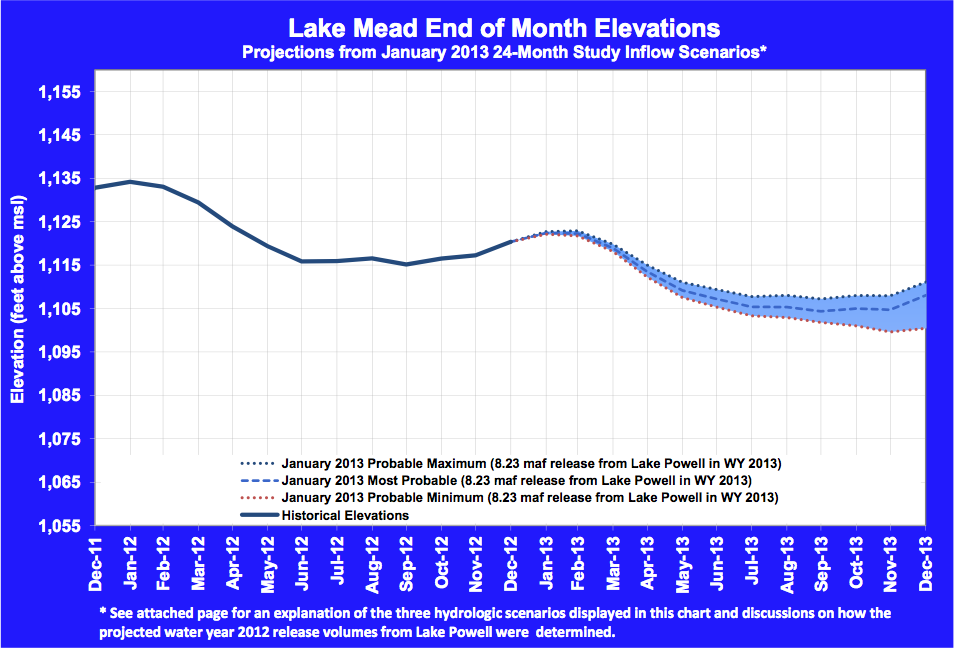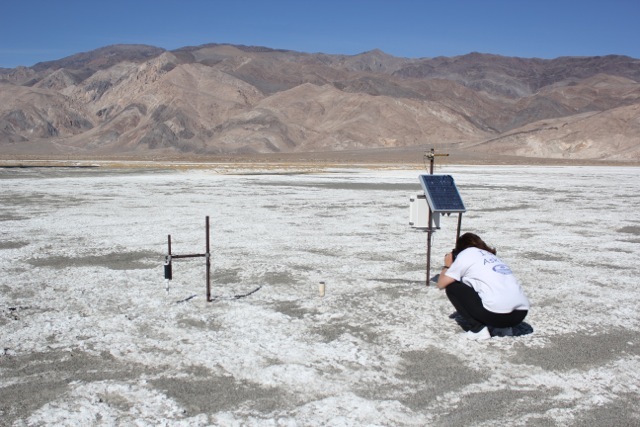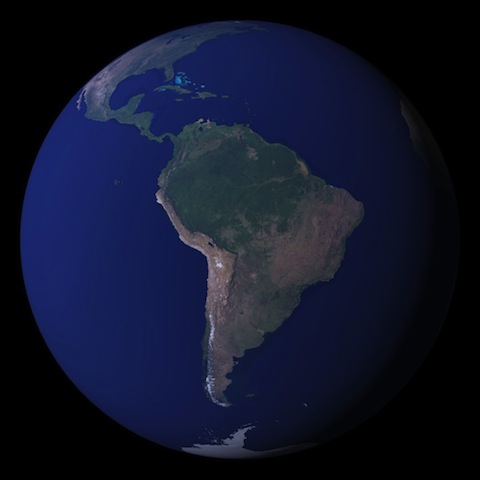“There is not enough water in the river”
Posted on | February 10, 2013 | No Comments
“Dropping out of the southern Rockies to carve a tiny corner from northwest New Mexico, the San Juan is the state’s largest river by volume, a ribbon of green in one of the driest parts of the state,” writes John Fleck in the Albuquerque Journal. “For part of its path, it passes through the Navajo Nation, the 25,000-square-mile Indian reservation spread across parts of New Mexico, Arizona and Utah. Some 7,000 square miles of the reservation are in New Mexico, home to an estimated 40,000 Navajo people.” Click on the map to keep reading Fleck on Navajo claims on the San Juan.
High good, low bad: Mead in January 2013
Posted on | January 31, 2013 | No Comments
 It’s a curious world in which the release of the same amount of water from an upstream Colorado River reservoir (Lake Powell) produces three different elevations in the receiving downstream reservoir (Lake Mead). But as this federal Bureau of Reclamation explanation of the dry, moderately dry and wet scenarios for the 2013 water year modeled in the above graphic spells it out, it’s all about the “intervening flows.” Those intervening flows diminish when snowpack in the Rockies is lousy and the river’s managers at Reclamation have to augment with previously impounded water.
It’s a curious world in which the release of the same amount of water from an upstream Colorado River reservoir (Lake Powell) produces three different elevations in the receiving downstream reservoir (Lake Mead). But as this federal Bureau of Reclamation explanation of the dry, moderately dry and wet scenarios for the 2013 water year modeled in the above graphic spells it out, it’s all about the “intervening flows.” Those intervening flows diminish when snowpack in the Rockies is lousy and the river’s managers at Reclamation have to augment with previously impounded water.
If the fund of previously impounded water were inexhaustible, we in the dry West would be less crazy relying on growth as a business model. But it’s not. And the lower we drive reservoir levels, the closer we come to shortages being called in contracted deliveries. To understand the balancing act that is managing the Colorado river — how much comes in every year, how much may be let out, and how those flows are likely to diminish in the face of climate change, everyone concerned with western water should attempt to penetrate the recently published Colorado River Basin Water Supply and Demand Study. For a future shock cousin of the relatively sedate decline modeled above, click on the jump for a graphic from the basin study’s Technical Report G “System Reliability Analysis and Evaluation of Options and Strategies.”
On the last day of January, 2013, the Colorado River’s system contents were estimated by Reclamation to be 55% full, 10% down from last year. Lake Mead hovered at around 1,122.39 feet, or roughly 53% full, more than 55 feet lower than the comparable closing elevation for January 2002, the year when it was finally recognized that a long-term dry spell was about to grip the Colorado system. At the end of January, 2013, Mead’s upstream feeder reservoir Lake Powell was 50% full. Click graphics to enlarge images.
Tags: chance of rain > Emily Green > Lake Mead elevations
When war zones look like home
Posted on | January 29, 2013 | No Comments

War in my lifetime has taken place abroad. Since becoming a California gardener in the late 1990s, however, the battlegrounds look a lot less foreign. It’s the plants. In Iraq, the date palms shaken by relentless bombing are the same species farmed in Coachella and then dug up from there and transplanted to line the avenues of Los Angeles and Las Vegas. Date palms are cited ten times in the Quran, according to Figs, Dates, Laurel and Myrrh: Plants of the Bible and the Quran. “In both holy books, palm trees are likened to humans,” observes its author, botanist Lytton John Musselman. Among his examples:
“Thy stature is like to a palm tree” (Song of Solomon 7:7, KJV)
“Which snatched away men as though they were palm trees pulled out by the roots.” (Sura 54:20, Ali)
Tags: chance of rain > Figs Dates Laurel and Myrrh > Lytton John Musselman > Timber Press
In praise of ‘Aqua Blog Maven’
Posted on | January 24, 2013 | 8 Comments

“Aquafornia” founder Chris Austin photographs the salt crust of Owens Dry Lake in the Eastern Sierra.
Last week Aquafornia quietly changed editorship. Its founder, Chris Austin, stepped aside and the Water Education Foundation, the blog’s owner since 2010, took over compilation. This post is to thank Austin, known better around the Internet as “Aqua Blog Maven,” for creating a website that every day for the last five and a half years provided a dazzlingly comprehensive news feed linking to stories big and small, sober and silly, about water in California.
Click here to keep reading
Reddit Water
Posted on | January 12, 2013 | No Comments
 As the stunningly sad news of the death of Reddit collaborator Aaron Swartz registers, this is a bow to the information-sharing service Reddit Water. If you don’t know about it, try it.
As the stunningly sad news of the death of Reddit collaborator Aaron Swartz registers, this is a bow to the information-sharing service Reddit Water. If you don’t know about it, try it.
« go back — keep looking »


